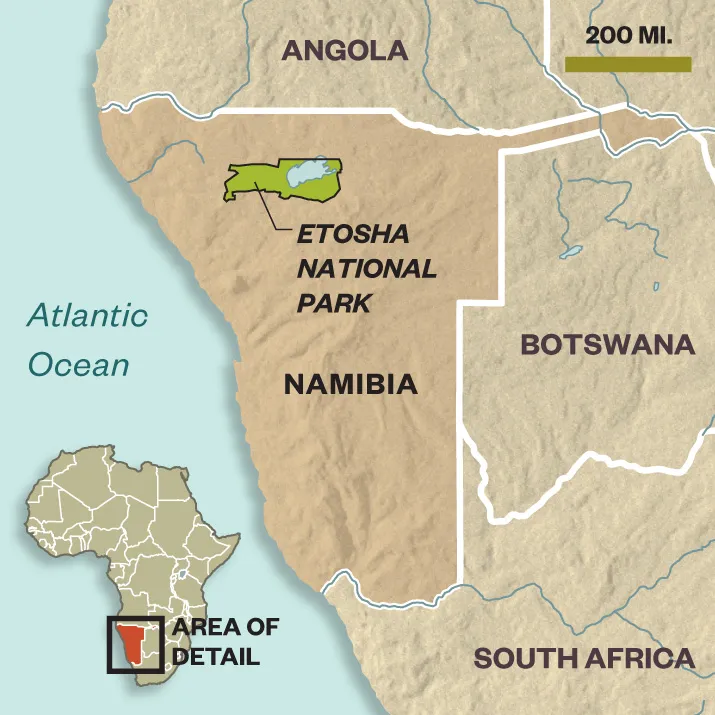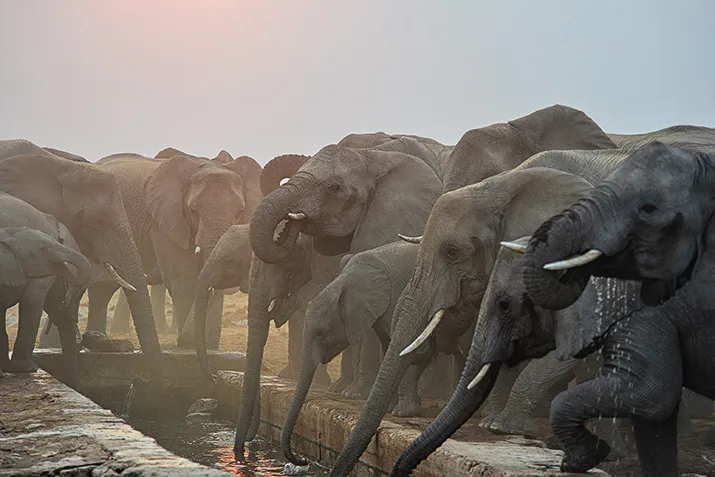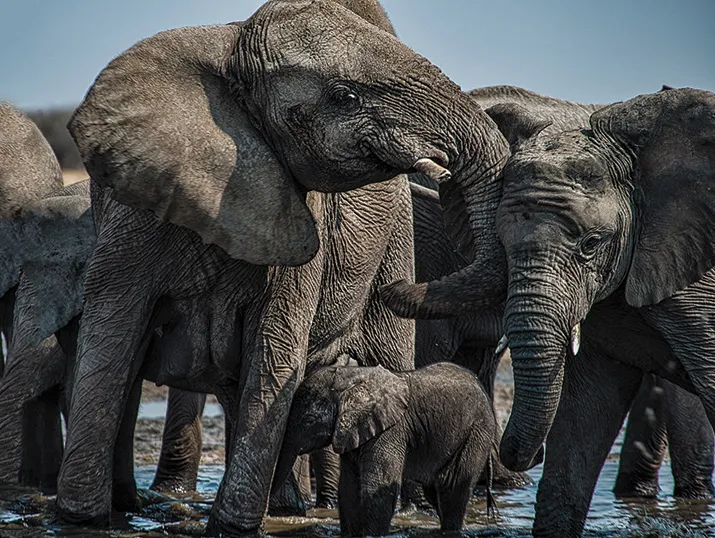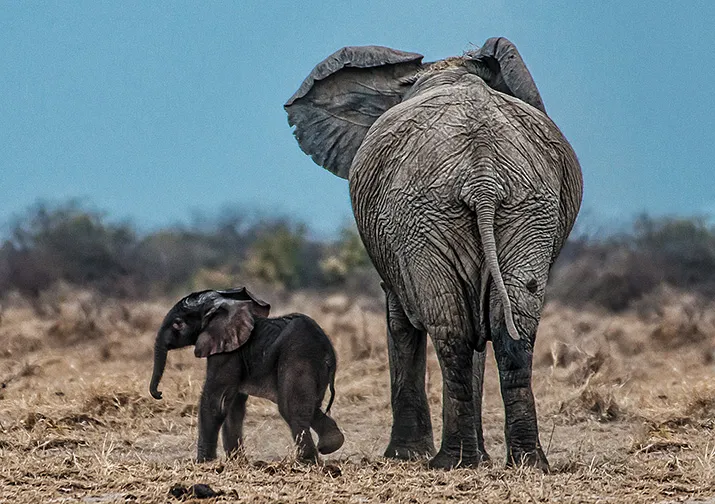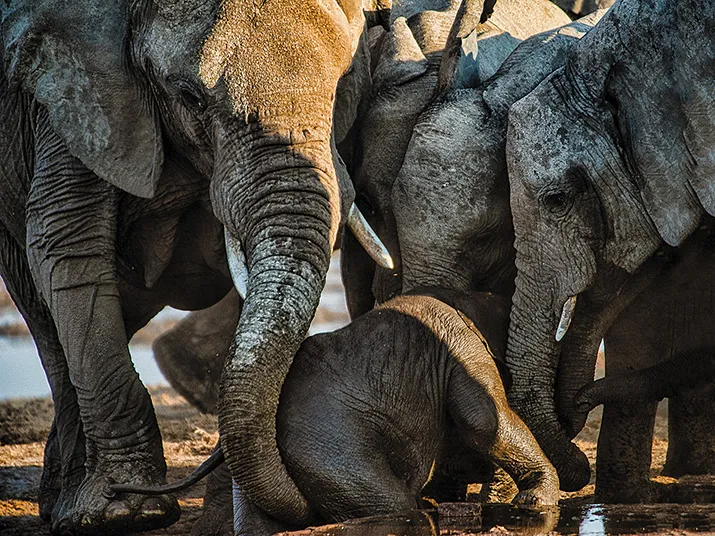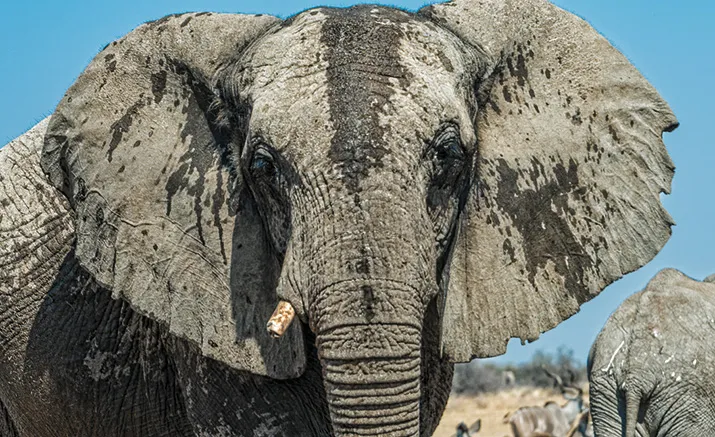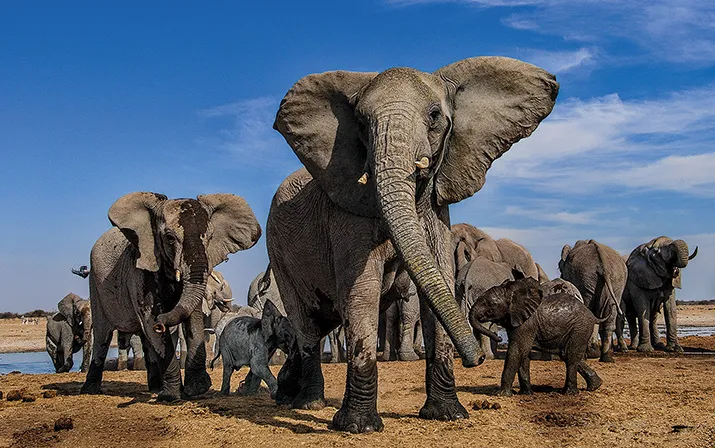The Meanest Girls at the Watering Hole
A scientist studying female elephants—usually portrayed as cooperative—makes a surprising observation about their behavior
/https://tf-cmsv2-smithsonianmag-media.s3.amazonaws.com/filer/Mean-Girls-elephants-at-Etosha-National-Park-631.jpg)
A roar broke the silence of a dead winter's night. When I heard the noise, I shot up and tossed back the hood of my sleeping bag, which I had pulled over my head to cut the chill. From my bed up in the research tower, I looked down at the water hole 20 feet below, now black since the moon had set several hours ago. This was my home during my elephant field season, and it offered a great view of elephants in action day and night.
I couldn’t make sense of the situation in the dark, so I reached for my night-vision scope. The shadows of four elephants came into view, too few for an extended family group. I watched an adult female marching up and down the most popular drinking spot, a concrete water trough fed by a natural spring. She swung her trunk back and forth, keeping the other three elephants away while she focused on the water. I zoomed in on her head, squinting for a clue to her identity. She lacked a left tusk and, when I looked at her left ear, I saw the shape of a “W” missing, the result of natural wear and tear. It was Wynona.
Now I could see that her companions were her male calf, her grown daughter and a granddaughter. But why weren’t they with the rest of the group? Something was amiss. I turned my attention back to Wynona, now skimming the water with her trunk, clearly agitated. What was she doing?
In the next moment, I saw the cause of her concern. A tiny head popped up out of the water, and Wynona dragged a wet and confused little calf out of the trough. I couldn’t believe it: Wynona, one of my favorite elephants, had a new baby.
Wynona had been looking pregnant since the beginning of the season, but I hadn’t thought that I’d be lucky enough to be around for the birth, which must have happened sometime in the 48 hours since the family’s last visit. In the 20 summers I’ve spent studying elephants at Mushara, a water hole in Etosha National Park, in north-central Namibia, I had never observed a birth here. The cows may have avoided giving birth at the water hole because the clearing surrounding it was too open, which would make newborns vulnerable to hungry lions and hyenas. Whatever the reason, the new calves I’d seen had usually had a few days to get their footing. By then, they and their mothers had rejoined the rest of the family.
Female elephants live in extended family groups of up to 30 members, who spend much of their lives near one another, bathing, foraging and socializing. But even before the birth of Wynona’s little one, her family relations seemed slightly off. Throughout the field season, she had been ostracized, even harassed. One day, just before the birth, I observed another elephant, named Susan (also pregnant), pushing Wynona away from the water hole. As far as I could tell, Wynona did nothing to instigate the bullying, which culminated in a trunk slap to her retreating rear end.
I also noticed aggressive behavior toward elephant calves. These little ones are normally coddled by everyone—caring moms, watchful aunts, playful siblings and cousins. But some calves weren’t receiving this support. I had even seen Susan, with a whack of her trunk, pushing another female’s baby away from the rest of the family. Such behavior made me wonder why Wynona’s extended family was absent for the birth of her calf. Although she and her immediate family may have just fallen behind the group, I was starting to consider another, darker possibility.
***
For two months each summer, my husband, Tim, and I set up camp at Mushara in the northeast corner of the park with a small research team. To get a good view but still give the elephants some space, we position our tower and camp behind a concrete bunker set back from the elephants’ prime gathering spot. After we remove the mice and snakes that took up residence in the bunker during our absence, we settle in to study our elephant subjects.
I always look forward to these summers with my field team of Stanford students, University of Namibia students and volunteers. During the academic year at Stanford, my previous work on seismic communication among elephants informs my studies of acoustics. I test new vibrotactile delivery designs in search of a new kind of hearing aid. But nothing beats spending summer nights at Mushara under the Milky Way during Etosha’s winter.
Among other things, we’ve learned during these seasons that male elephants are much more social than previously described. We began studying hierarchies and rituals among the bulls as they vied for dominance and sought companionship. Although male elephants have a reputation as loners—they leave their mothers’ extended families between the ages of 12 and 15—we saw them band together in what I call “boys’ clubs,” jockeying for favor with the highest-ranking male.
This year we turned our attention back on the females. Elephant family groups are matriarchal, with the oldest female leading her daughters, granddaughters and other female kin, usually anywhere from 15 to 30 animals in all. (The number varies elsewhere; in Amboseli National Park, in Kenya, groups of 2 to 20 have been reported.) Often daughters, younger sisters and cousins pitch in to raise others’ babies—more care increases the probability that the calf will survive, meaning more family genes are passed to the next generation.
There is a pecking order among the families. In fact, we often identify the matriarchal groups by the distinguishing physical features of their leaders, giving them family names such as the Bent Ear, the Crumple Ear and the Crooked Tail clans, as well as the Actors led by Queen, the Athletes led by Mia and the Warriors led by Left Tusker. Clear ranks emerge even amid the pandemonium of three, four or sometimes five extended families arriving at the Mushara water hole—more than 200 elephants on some occasions.
I recall when three groups arrived at the water hole around the same time. The family that was first to the trough was quickly displaced by another, which occupied the best drinking spot (akin to the seat at the head of the table) unchallenged throughout the visit. Members of a third family weren’t given access to the trough at all and were displaced even from the surrounding shallow clay pan. Standing in a clearing, these low-ranking elephants huddled and rumbled until it was their turn.
There is also hierarchy within elephant families, and research has shown that rankings are determined by age and size, with the oldest or largest females at the top. Susan, for example, was larger and most likely older than Wynona. But Susan’s status didn’t fully explain why she pushed Wynona around.
I had been monitoring Wynona since the 2005 season, and had observed what seemed like the entire family ganging up on her. Now I realized that a few good seasons of rain meant that more than the usual number of babies were born in the past few years. But this year, the rain came early, so things dried up sooner than normal. With so many elephants and very little available water, not only families but also individuals within families were competing with one another for access.
Another low-ranking female, Greta, in the Actor family, was also shunned by her own family members, as was her little calf Groucho. And the most dramatic case was Paula, from the Athlete family, who was aggressively bullied by all the others. Again I saw that it wasn’t just the low-ranking females who were marginalized—their calves were too.
That was in stark contrast to the treatment of new babies of high-ranking females in the Warrior clan, currently the most dominant family at Mushara. I’d seen three Warrior calves early in the day happily splashing together in the water hole pan, with no aggression directed at them. I’d also witnessed high-ranking females rescue a high-ranking baby that had fallen into the trough: In one case, I saw Mia, the Athlete family matriarch, kneel down and lift a calf of a high-ranking female out of the water as the calf’s mother stood by seemingly bewildered, not knowing what to do. Afterward, several family members gathered around to comfort the distraught youngster.
During the whole episode, Paula and her baby, Bruce, stood off in the distance. I wondered whether Mia would have done the same for Paula’s little one. After the poor treatment she’d received all season, I couldn’t imagine an elephant coming to Paula’s aid, much less the matriarch. Paula probably would have been left to handle the crisis alone (if she could have).
At this water hole, it seemed, hierarchy trickled down, with rank not dependent on age and size alone. Offspring of subordinate females were themselves subordinate. Perhaps, I began to think, high status could be hereditary, creating a kind of elephant royalty—and elephant peasants.
The concept of a caste system brought me back to Wynona and the poorly attended birth of her new baby. With so much aggression toward low-ranking little ones, perhaps Wynona put some distance between herself and extended family members to protect her baby from their hostile behavior.
Researchers often describe female elephants as living in “fission-fusion” societies. But the implication is that the fission dynamic—the forces pulling the groups apart—is passive, that somehow the optimal number of elephants that forage and survive together is achieved when extended families slowly develop looser connections and become more distantly associated.
I was now starting to realize that the dynamic might be active, possibly following the direct bloodline of the matriarch, where only the highest-ranking, or “queen,” elephant and her direct descendants are welcome to hold court around the best water. Others are pushed away, forced to splinter off into separate groups.
There had to be an explanation for such targeted aggression toward family members. In other areas of Africa, where poaching is more prevalent, unrelated females have joined together to form new groups. Hostilities in those makeshift families might make sense, but elephants at Mushara are not under the same kind of pressure. What’s more, according to our records, both Paula and Wynona had been living within their families for at least the past eight years. And while it’s conceivable that a whole family might ostracize a sick elephant, chances were low that Paula, Wynona, Greta and their calves were all ill.
It struck me how much energy the higher-ranking females devoted to keeping the heat on the lower-ranking ones, not to mention the coordination involved. Mia trunk-slapped Paula again and again and again.
Perhaps the concepts of optimal foraging and survival of the fittest were at work here—that group sizes had to be maintained at a number that optimized the foraging opportunities of higher-ranking females and their calves in order to ensure the survival of the next generation. The chances that a calf would survive would increase with group size to a point. But a larger group at some point could become a hindrance, making it harder to find enough food, particularly in dry years.
As for Paula, Wynona and Greta, the matriarchs of their families might be ostracizing them in an effort to preserve the reproductive success of the higher-ranking and perhaps more closely related individuals—even if it takes energy in the short term to consistently antagonize subordinates and their offspring. Alternatively, this concerted effort might exist to minimize or prevent reproduction in lower-ranking females.
By collecting fecal DNA from as many individuals and family groups as possible, I hoped to piece together an extended family tree that would either support my hypothesis or further complicate the picture. But that would take time, at least an additional year to finish the data collection and analysis needed. All I had in front of me was the behavior, and I did my best to document it. I reported a number of my observations in a blog I wrote last year for the New York Times, but only later did I formulate the evidence I’d accumulated into this hypothesis: Hierarchy is hereditary and it is the driver of an active, not passive, fissioning process.
As the season wound down at the beginning of August, the wind started to pick up. The dust of Etosha Pan blanketed the sky as twisters funneled their way across the clearing. The elephants were slower in coming to the water hole, the environment interfering with the smells and sounds that help them navigate.
The relative calm gave me time to assess Paula’s situation, which was clearly taking its toll on her and her calf, Bruce. She was with the Athletes a few days ago looking stressed. And Bruce hadn’t yet gained sure footing. On that occasion, the whole family came barreling in as usual, but this time headed straight for the pan for a cooling bath before going to drink from the trough.
Paula went for the pan as well, possibly not realizing that, with the heat of the day, this had become a prized locale. She clashed with another high-ranking elephant, while Bruce scampered off to avoid getting slugged by an angry trunk.
After the altercation, higher-ranking females repeatedly pushed Paula away. Mia barely drank, instead training her gaze on Paula, who kept her distance. Bruce did not escape the pressure. Not only was he deprived of a social experience, but he was also losing energy. Paula repeatedly tried to lift Bruce to a standing position using her hind foot as an elevating crutch, but to no avail. He wasn’t even able to nurse.
This is when I noticed Paula’s shriveled mammary glands. She was nowhere near as full as the other new mothers, as if the intensity of her social plight had stopped lactation.
Could it be that lower-ranking cows were more stressed and thus had fewer offspring? If so, hormonal suppression could indeed be a factor within female elephant hierarchies. But it could be more complicated, as in the case of marmoset groups; female subordinates don’t reproduce at all because of socially induced suppression of ovulation. These female monkeys’ cortisol levels drop to extremely low levels, changes similar to those seen in some women experiencing acute or chronic stress.
Other researchers have suggested that one reason certain elephant families with older individuals succeeded in having more calves during droughts was that the more experienced animals knew how to cope with the challenge. And other research has demonstrated that dominant families had access to better forage, so it would make sense that they might have higher overall reproductive fitness. But how did this play out between females within the same extended family? Did similar-aged females have the same number of calves on average, or did more distantly related family members have reduced reproductive fitness? Other elephant researchers had decided that dominance rank is not a predictor of female reproductive fitness, but maybe that question needs revisiting.
Reproductive suppression is well documented elsewhere in nature, either through endocrine or behavioral mechanisms or both, notably in primates such as baboons, mandrills and marmosets, but also in African wild dogs, dwarf mongooses and other species. Although it hasn’t been described yet in elephants, perhaps at least in tough times dominant females in my study population and their direct bloodline were exhibiting intolerance toward family members that were one step removed from the queen.
***
In the evenings, when I climbed into my sleeping bag, I wondered how Bruce would pass the night. Was Paula going to be able to protect her increasingly vulnerable little calf from predators? Despite the poor treatment she received, Paula probably wouldn’t risk going off on her own with such a small calf. Unlike Wynona, she had no other immediate family for support. As hard as it was to watch, I understood that I was most likely witnessing a natural fission of elephant families.
I nestled in farther to take the chill off and looked out at the Southern Cross hanging sideways in the sky. The kitelike constellation seemed close enough to touch. I heard a jackal to the east, emitting the signature alarm bark that to me sounded like “Lion! Lion! Lion! Ru-ru-ru!” I hoped that elephant was not on the menu tonight. But if it was, I understood. Everything I witness each field season is part of a natural order. Community, companionship, rejection, defeat and death are followed by renewal—and perhaps, for the elephants, and in particular, Wynona, that means becoming the queen of a brand-new family.
